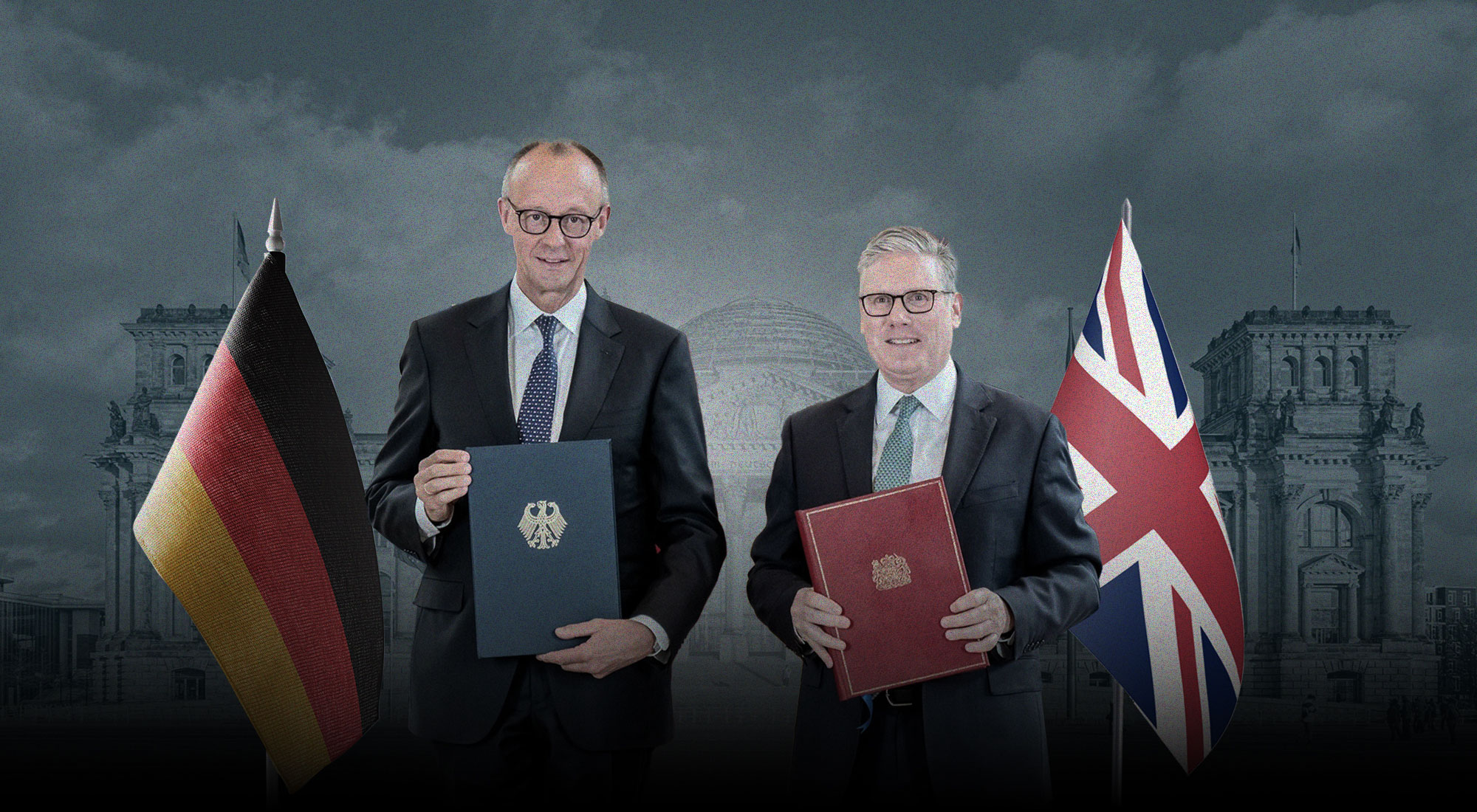The Treaty on Friendship and Bilateral Cooperation between Germany and the United Kingdom, signed in London on 17 July 2025, marks a significant milestone in the evolving landscape of European security.[1] Coming at a time of deep geopolitical uncertainty, this bilateral agreement reflects the shifting strategic calculus among European powers in response to growing doubts over the long-term reliability of U.S. commitments to NATO. As Washington continues to recalibrate its global military footprint, and populist pressures grow within U.S. politics to scale back international entanglements, European states are increasingly compelled to assume greater responsibility for their own security.
Against this backdrop, the Germany-UK treaty stands out as a bold and timely initiative. It introduces a comprehensive framework for cooperation that encompasses mutual defense commitments, migration control, infrastructure development, technological innovation, and cultural exchange. Crucially, while it does not seek to replace NATO, it aims to complement and reinforce European strategic autonomy by creating more flexible and politically agile mechanisms of bilateral coordination. This reflects a broader trend toward building a “European pillar” within NATO or even laying the groundwork for future independent defense capabilities on the continent.
This paper aims to analyze the treaty’s implications through three key dimensions. First, it examines the treaty’s mutual assistance clause and its significance for the future of bilateral security cooperation in Europe. Second, it explores the broader policy areas embedded in the agreement—including migration, sustainability, and innovation—that signal a holistic approach to strategic alignment. Finally, it highlights the treaty’s emphasis on youth mobility and cultural cooperation as a vital investment in the long-term resilience of UK-German relations. Through this lens, the paper argues that the 2025 treaty is not merely a political document but a strategic blueprint for a new era of European security cooperation.
I. Content of the Defense Treaty
While its core lies in a security pact, the treaty is far more than a traditional military alliance. It represents a broad strategic alignment that encompasses defense, migration, infrastructure, innovation, and cultural cooperation. The following section explores the key dimensions of the treaty, highlighting its transformative potential in reshaping not only London-Berlin relations but also the broader European security and integration landscape.
1. Mutual Assistance Clause and Strategic Realignment
At the heart of the treaty lies a powerful mutual assistance clause stipulating that any strategic threat to one nation will be treated as a threat to the other.[2] This provision echoes the foundational Article 5 of the NATO treaty, yet its significance lies in the bilateral context in which it is being enacted.[3] Unlike NATO’s collective defense mechanism, which requires consensus among all members, this clause allows London and Berlin to act swiftly and jointly in the face of evolving threats—from conventional military aggression to hybrid warfare, cyberattacks, and even emerging security risks in space and AI domains.[4] By affirming this pledge, the UK and Germany signal a deliberate effort to deepen their strategic convergence at a time of rising global instability and uncertainty over the long-term reliability of broader alliances. The clause underscores a maturing security relationship between Europe’s largest economies and reflects post-Brexit recalibrations in British foreign policy. Moreover, this bilateral defense posture marks a shift toward a new form of European security architecture—one where minilateral treaties supplement broader alliances like NATO or the EU’s Common Security and Defense Policy. While not meant to replace these institutions, the treaty shows how major European powers are hedging against fragmentation and seeking more agile mechanisms of coordination. The clause could also become a template for future agreements, particularly if U.S. security commitments become less predictable. In essence, this is more than a military pact—it is a strategic signal that Germany and the UK are reasserting their roles as co-pilots of European security in an increasingly multipolar and unstable global order.
2. Broader Scope: From Migration Control to Scientific Innovation
Beyond defense, the Germany-UK mutual treaty reflects a forward-looking vision that transcends traditional military cooperation. It includes substantial commitments in non-military domains such as combating illegal migration, advancing infrastructure and sustainability, enhancing scientific collaboration, and fostering youth and cultural exchange. These components are not secondary; they demonstrate how the treaty is grounded in a comprehensive understanding of 21st-century security—one that recognizes social cohesion, environmental resilience, and technological leadership as strategic imperatives. The clause on illegal migration highlights shared concerns over border integrity, asylum management, and the trafficking of vulnerable populations. Both the UK and Germany have struggled with complex migration challenges in recent years, and this partnership provides a mechanism to share intelligence, harmonize policy, and possibly support joint operations at key transit points in Europe and beyond.[5]
Meanwhile, the inclusion of transport and sustainability infrastructure reflects the interconnected nature of energy security, supply chain resilience, and environmental strategy. By jointly investing in green transport corridors and sustainable logistics, the two nations aim to lead Europe’s transition to net-zero while also securing critical infrastructure from geopolitical disruptions. Scientific innovation also features prominently, with a focus on pooling R&D efforts, sharing data and technologies, and coordinating in key fields such as AI, quantum computing, and climate research. In a world increasingly defined by tech rivalry, such bilateral scientific alignment enhances both countries’ competitiveness and strategic autonomy. Together, these dimensions make the treaty a multifaceted framework for a modern strategic partnership.
3. Youth Mobility and Cultural Cooperation: Investing in Shared Identity
A particularly notable feature of the treaty is its emphasis on youth mobility and cultural cooperation. While defense clauses typically dominate headlines, the long-term success of any alliance rests equally on shared values, mutual understanding, and intergenerational exchange. Recognizing this, London and Berlin have committed to expanding opportunities for young people to study, work, and volunteer across borders. These efforts may take the form of bilateral scholarships, expanded access to student exchange programs like Erasmus+ (post-Brexit alternatives for the UK), joint language and arts initiatives, and vocational training schemes. Such programs are crucial in maintaining the deep societal ties between two of Europe’s most influential countries—especially as political and institutional frictions persist in the wake of the UK’s departure from the EU.
Cultural cooperation further reinforces this people-centered diplomacy. The treaty aims to boost collaboration between cultural institutions, museums, and artists, promoting joint exhibitions, co-productions, and digital platforms that celebrate shared heritage and diverse narratives. These exchanges play a subtle yet powerful role in countering nationalism, xenophobia, and historical amnesia by emphasizing common values and mutual respect. In the context of rising geopolitical polarization and domestic political pressures in both countries, cultural diplomacy becomes not just symbolic but strategic—reinforcing democratic resilience and social cohesion.
Additionally, fostering youth engagement in policy dialogues—particularly in areas like climate, technology, and global governance—positions the Germany-UK axis as a platform for future-oriented leadership in Europe. Through these soft power mechanisms, the treaty moves beyond transactional cooperation toward building a shared identity between societies. This dimension of the treaty—often overlooked—may prove to be its most durable legacy, as it plants the seeds for a more integrated, empathetic, and strategically aligned generation of transnational citizens.
II. Strategic and Security Dimensions
1. Strengthening European Deterrence
The Germany-UK defense treaty marks a pivotal development in reinforcing Europe’s strategic autonomy and deterrence capabilities. For Germany, this agreement is especially significant as it provides Berlin with a defense assurance from a second European nuclear power, following its close cooperation with France. This two-pronged nuclear partnership enhances the credibility and depth of Europe’s own security guarantees, especially at a time when the reliability of transatlantic commitments is under increasing scrutiny. The initiative reflects Chancellor Friedrich Merz’s long-standing advocacy for a stronger, more independent European security framework, capable of acting decisively in times of crisis without over-reliance on the United States.[6] The treaty sends a powerful signal that European powers are willing to step up and assume greater responsibility for the continent’s defense. It also symbolizes the maturing of German strategic thinking, moving from a historically cautious military posture to one that embraces proactive security partnerships. The added layer of deterrence, backed by the UK’s nuclear capabilities and advanced military infrastructure, bolsters Europe’s ability to respond to both conventional and hybrid threats. In essence, the treaty lays the groundwork for a more resilient and self-reliant Europe, better positioned to confront the evolving security challenges of the 21st century.
2. Post-Brexit Britain
For the United Kingdom, the defense treaty with Germany is a calculated strategic move to reassert its influence on the European stage following Brexit. Prime Minister Keir Starmer’s foreign policy has prioritized rebuilding bridges with European allies without renegotiating EU membership.[7] This treaty exemplifies that approach, signaling Britain’s willingness to engage deeply with key European powers through robust bilateral arrangements. By aligning with Germany—the EU’s economic engine and a central actor in European security—the UK gains a platform to shape continental security debates and remain relevant in Europe’s evolving defense landscape. The agreement allows Britain to play a pivotal role in shaping European security, thereby offsetting some of the diplomatic and strategic isolation that resulted from leaving the European Union. Moreover, it positions the UK as a reliable and indispensable partner, particularly as the continent faces renewed geopolitical threats from Russia and global instability. This renewed partnership is not just symbolic; it reflects a shared vision for a secure Europe built on cooperation and mutual defense. For Starmer, the treaty is an example of “realignment without reentry,” giving substance to a post-Brexit vision that keeps Britain firmly tied to Europe’s strategic future.
3. Complementing NATO
While the treaty firmly reaffirms both countries’ enduring commitment to NATO, it also reflects a growing recognition that Europe must develop complementary security mechanisms capable of operating independently when necessary. In an era marked by U.S. political volatility and the rise of isolationist rhetoric in Washington, European capitals are increasingly aware of the risks of overdependence on American leadership. The bilateral nature of the Germany-UK agreement signals a shift toward diversified defense structures that can act swiftly and coherently, even in scenarios where NATO’s collective response might be delayed or politically constrained. Rather than undermining NATO, the treaty enhances it by building European capacity and encouraging more equitable burden-sharing among allies. This development aligns with longstanding calls from within NATO for Europe to assume greater responsibility for its defense.[8] It also facilitates joint planning, force interoperability, and intelligence sharing at a level of trust and speed that multilateral frameworks sometimes struggle to achieve. Importantly, this move reflects an adaptive and forward-looking European security posture—one that values NATO but prepares for a future where regional defense initiatives must be able to stand on their own when needed, especially in a rapidly shifting geopolitical environment.
III. Political Background of the Treaty
1.The Starmer-Scholz Declaration
The treaty stems from the Starmer-Scholz Declaration, a key agreement made in the summer of 2024. This declaration set the foundation for a closer bilateral relationship between the two nations, with a focus on shared security interests, economic collaboration, and sustainability. It acknowledged the evolving challenges faced by Europe, particularly in the face of global political instability and environmental concerns. The declaration envisioned a partnership that would transcend traditional alliances, underscoring the need for European unity and autonomy in addressing these challenges. The strategic cooperation outlined in the document includes bolstering defense capabilities, aligning economic policies to promote growth and stability, and advancing green technologies. It also highlighted the importance of collaboration in scientific research and technological innovation. This declaration paved the way for the 2025 defense treaty, which further formalizes these commitments and solidifies the bilateral ties between the two countries, making the treaty a logical progression of their shared vision for a secure and sustainable Europe.
2. Intensive Negotiations
The treaty is the product of extensive and rigorous negotiations, spanning 18 rounds of talks between the two nations. These negotiations involved careful deliberation over various issues, including defense policy, economic collaboration, and environmental sustainability. The process included five face-to-face meetings, three of which were held in Berlin and two in London, underscoring the importance both leaders placed on direct dialogue. The negotiators from both sides demonstrated considerable political will, working tirelessly to ensure that the treaty would address the most pressing issues of European security. The high number of meetings and the deep involvement of top-level officials reflect the complexity of the agreement and the willingness of both governments to ensure that it would have a far-reaching impact. The lengthy negotiation period also highlights the sensitivity of the topics being discussed, as both parties sought to balance national interests with a shared commitment to European stability. As a result, the treaty represents a significant diplomatic achievement, grounded in mutual understanding and a shared vision for the future.
3. European Context
The timing of the Germany-UK defense treaty is crucial, coming at a moment of heightened security challenges across Europe. The ongoing war in Ukraine, which has dramatically shifted the security landscape in the region, has prompted a reassessment of Europe’s defense strategies. In addition to military threats, Europe faces rising cyber threats, as well as mounting pressures from irregular migration flows, all of which contribute to instability. These developments have forced major European powers to rethink their approach to regional security, driving them toward stronger bilateral and multilateral agreements. In this context, the Germany-UK defense treaty represents a proactive response to these unprecedented challenges. By forming a closer defense partnership, the two countries are not only addressing their immediate security needs but also reinforcing the broader European security architecture. The treaty emphasizes the importance of European self-reliance, ensuring that key powers within the region can respond effectively to emerging threats. Furthermore, it highlights the need for robust regional collaboration to enhance both defense capabilities and the resilience of European economies and societies in the face of evolving threats.
IV. Controversies and Challenges
1. Migration and Youth Mobility
The migration and youth mobility agenda is one of the most controversial aspects of the Germany-UK defense treaty. While both countries agreed to collaborate on combating illegal migration, especially in response to growing pressures on Europe’s borders, the issue of legal migration, particularly youth mobility, remains politically sensitive. In the United Kingdom, the domestic political climate remains charged with concerns over immigration control, a legacy issue from Brexit. Prime Minister Keir Starmer is under continuous pressure from both centrist and right-wing segments of the electorate to enforce stricter regulations on all forms of immigration, including student and work visas.[9] This has made any formal bilateral commitment to expanding youth mobility programs difficult. German officials, on the other hand, see youth exchange and labor mobility as crucial to fostering deeper integration and cooperation. They argue that limiting such mobility undermines the spirit of bilateral engagement and reduces opportunities for cross-cultural learning and skills development. The tension between managing security and upholding openness creates a delicate balancing act for treaty implementation. Without clear mechanisms to reconcile these diverging priorities, migration and youth mobility may remain an unresolved point of contention and a potential flashpoint for public criticism in both countries.
2. Sovereignty Concerns
Another significant challenge arising from the treaty revolves around national sovereignty and the perceived erosion of autonomous decision-making in defense matters. In Germany, critics warn that closer bilateral military cooperation with a non-EU power like the United Kingdom could weaken long-standing calls for a unified European defense policy and a potential common European army. Some policymakers in Berlin worry that overlapping bilateral alliances could fragment Europe’s defense landscape rather than unify it. They fear that such treaties might create parallel structures that compete with EU institutions instead of reinforcing them. Meanwhile, in the United Kingdom, domestic parliamentary control is a greater source of concern. Skeptics argue that deeper security cooperation may pave the way for British military involvement abroad without sufficient parliamentary oversight, a highly sensitive issue given the UK’s past military engagements in Iraq and Afghanistan. The fear is that binding agreements could limit Britain’s ability to act—or abstain—from certain defense actions, particularly if triggered by joint clauses in the treaty. These sovereignty-related anxieties highlight the deep political sensitivities still attached to national defense, even within allied nations, and could affect future political support or ratification processes related to the treaty.
3. EU Coordination
Although the treaty is framed as a bilateral initiative, it inevitably raises broader questions about its implications for EU defense coordination and strategic coherence. For Brussels and several EU member states, the treaty is being closely watched: is it a potential model for enhanced European defense cooperation, or does it represent a fragmented, ad hoc approach that risks bypassing EU mechanisms? On one hand, proponents argue that this bilateral agreement could act as a catalyst, encouraging other EU countries to form similar strategic alliances, especially amid growing doubts about the U.S. commitment to NATO and the rising threats from Russia and other adversaries. On the other hand, skeptics within the EU see it as a deviation from collective European efforts—one that may undermine solidarity and produce competing security structures. The fact that the UK is no longer an EU member adds complexity; while London seeks influence in European security, it does so from outside the formal EU apparatus. For now, the treaty remains an isolated experiment, but if it succeeds in enhancing readiness and trust, it could serve as a blueprint for future defense pacts within or adjacent to the EU framework. The key issue remains alignment versus divergence.
V. Geopolitical Implications
1. Europe Beyond NATO?
The treaty reflects a growing undercurrent of European uncertainty regarding the long-term reliability of U.S. security guarantees, particularly under the shadow of rising American isolationism. Since President Trump’s first term and the ongoing unpredictability of U.S. political transitions, many European leaders have begun to question the wisdom of relying solely on NATO, which is heavily U.S.-centric. While the treaty explicitly reaffirms Germany and the UK’s commitment to NATO, its bilateral framework subtly signals a European willingness to prepare alternative or parallel defense mechanisms if necessary. It represents an acknowledgment that the transatlantic bond, though vital, cannot remain the sole pillar of European defense planning.[10] The idea of “strategic autonomy”—once aspirational—is increasingly becoming a practical necessity. Germany’s defense guarantees from both the UK and France now place it at the center of a developing web of intra-European military pacts. If these initiatives proliferate, Europe may witness a gradual evolution toward a multipolar defense architecture, in which NATO remains essential but no longer exclusive. This raises profound strategic questions about coordination, interoperability, and the political cohesion of Western defense commitments in a post-American Europe.
2. Message to Russia
The treaty sends a deliberate and unambiguous message to Moscow: European nations are willing and able to create new security alignments that operate independently of U.S. military command. Since the onset of the Ukraine war, Russia has repeatedly sought to exploit perceived rifts within NATO and sow doubt about Western unity.[11] However, this bilateral treaty challenges that strategy by demonstrating that key European powers are not only committed to mutual defense but also capable of forming rapid-response alliances beyond the NATO framework. It reflects a European determination to defend their sovereignty and territorial integrity without waiting for Washington’s approval or leadership. From Moscow’s perspective, this development raises the stakes. It reduces the strategic value of fragmenting NATO, as European nations now show the political will to deepen cooperation through multiple channels. The treaty’s deterrent impact lies not just in military capability but in the clarity of its political resolve. For Russia, which has long capitalized on hesitation and division within Europe, the formation of robust bilateral defense agreements is a concerning shift—one that suggests the Kremlin’s aggression may only be met with greater cohesion and preparedness across the continent.
Conclusion
The 2025 Germany-UK Defense Treaty represents a defining moment in the evolution of European security architecture. Beyond the formalities of a bilateral defense pact, it embodies a strategic recalibration in response to shifting global power dynamics, uncertainty over transatlantic commitments, and the need for Europe to assert greater autonomy in safeguarding its future. By combining robust military assurances with a comprehensive agenda encompassing migration, sustainability, innovation, and cultural exchange, the treaty reflects a holistic understanding of 21st-century security—one that integrates hard power, soft power, and societal resilience.
Crucially, the treaty signals the emergence of a more agile, multipolar European defense paradigm. It demonstrates that key European actors are willing to develop rapid-response capabilities and minilateral mechanisms alongside NATO, not in opposition to it, thereby enhancing both deterrence and strategic flexibility. At the same time, the emphasis on youth mobility and cultural cooperation underscores a forward-looking approach: Europe’s security is not merely a matter of military strength but also of shared identity, mutual understanding, and intergenerational cohesion.
Geopolitically, the treaty sends clear messages across multiple fronts. It reassures partners of Europe’s capacity for self-reliance, subtly recalibrates relationships with France and the EU, and asserts a united front to Russia in an era of persistent instability. By institutionalizing a framework for bilateral and, potentially, multilateral European defense collaboration, the Germany-UK treaty sets a precedent for future initiatives, highlighting the continent’s readiness to take ownership of its strategic destiny.
In essence, this agreement is both a product and a catalyst of a new European security ethos: one where sovereignty, cooperation, and innovation converge to ensure resilience in an uncertain world. The 2025 treaty is more than a document of mutual defense—it is a blueprint for Europe’s path toward strategic autonomy, demonstrating that the continent is prepared not only to respond to threats but also to shape the international security order on its own terms.
[1] Federal Foreign Office, “For security and prosperity in Europe: Germany and the United Kingdom of Great Britain and Northern Ireland conclude a Treaty on Friendship and Bilateral Cooperation,” Auswärtiges Amt, July 17, 2025,
[2] “Germany, UK Sign Mutual Assistance Defence Pact, Reports Politico,” Reuters, July 2, 2025, accessed July 7, 2025, https://www.reuters.com/business/aerospace-defense/germany-uk-sign-mutual-assistance-defence-pact-reports-politico-2025-07-02/.
[3] Lidia Gibadło and Jacek Tarociński, “Germany-UK Treaty: A Historic Agreement in Difficult Times,” Centre for Eastern Studies (OSW), July 24, 2025, https://www.osw.waw.pl/en/publikacje/analyses/2025-07-24/germany-uk-treaty-a-historic-agreement-difficult-times.
[4] Federal Foreign Office, “For security and prosperity in Europe: Germany and the United Kingdom of Great Britain and Northern Ireland conclude a Treaty on Friendship and Bilateral Cooperation,” Auswärtiges Amt, July 17, 2025: https://www.auswaertiges-amt.de/en/aussenpolitik/laenderinformationen/grossbritannien-node/2727346-2727346.
[5] Government of the United Kingdom, “Friendship and Bilateral Cooperation Treaty: The 17 Projects the UK and Germany Will Deliver Together,” Gov.uk, July 17, 2025, https://www.gov.uk/government/news/friendship-and-bilateral-cooperation-treaty-the-17-projects-the-uk-and-germany-will-deliver-together.
[6] Patrick Wintour, “Merz Strikes Urgent Tone in Calling for More European Independence from US,” The Guardian, February 24, 2025, https://www.theguardian.com/world/2025/feb/24/friedrich-merz-germany-europe-independence-from-us.
[7] Nicolai von Ondarza, “After Brexit, E3 New Treaty Puts UK, Germany, and France Back at the Heart of European Security,” Chatham House, July 18, 2025, https://www.chathamhouse.org/2025/07/after-brexit-e3-new-treaty-puts-uk-germany-and-france-back-heart-european-security.
[8] “What difference will the ‘historic’ UK-Germany treaty make?,” The Week, July 18, 2025, https://theweek.com/politics/uk-germany-treaty-starmer-brexit-reset.
[9] Andrew Macaskill and Sarah Young, “UK’s Starmer Under Pressure as Farage Tightens Migration Rules,” Reuters, May 12, 2025,
[10] Douglas Barrie, Nick Childs, and Ben Schreer, “UK–Germany Defence Agreement: What Kind of Trinity?,” International Institute for Strategic Studies, November 5, 2024, https://www.iiss.org/ar-BH/online-analysis/military-balance/2024/11/uk-germany-defence-agreement-what-kind-of-trinity/
[11] Associated Press, “UK and Germany sign ‘historic’ defence treaty amid Russia concerns,” MyNews, July 17, 2025, https://www.scmp.com/news/world/europe/article/3318644/uk-and-germany-sign-historic-defence-treaty-amid-russia-concerns.









